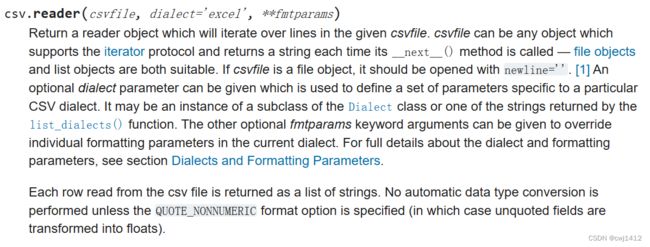Python3和Python2关于csv文件的读写区别
今天在处理数据的时候遇到了一个因为python版本不同,导致csv读写出错的问题。
我首先在Python 2.7的环境下抽取特征,按照一定的格式存成csv文件:
def get_detections_from_im(net, im_file, image_id, conf_thresh=0.2):
im = cv2.imread(im_file)
scores, boxes, attr_scores, rel_scores = im_detect(net, im)
# Keep the original boxes, don't worry about the regresssion bbox outputs
rois = net.blobs['rois'].data.copy()
# unscale back to raw image space
blobs, im_scales = _get_blobs(im, None)
cls_boxes = rois[:, 1:5] / im_scales[0]
cls_prob = net.blobs['cls_prob'].data
pool5 = net.blobs['pool5_flat'].data
......
return {
'image_id': image_id,
'image_h': np.size(im, 0),
'image_w': np.size(im, 1),
'num_boxes' : len(keep_boxes),
'boxes': base64.b64encode(cls_boxes[keep_boxes]),
'features': base64.b64encode(pool5[keep_boxes])
}
with open(outfile, 'ab') as tsvfile:
writer = csv.DictWriter(tsvfile, delimiter = '\t', fieldnames = FIELDNAMES)
......
for im_file,image_id in image_ids:
writer.writerow(get_detections_from_im(net, im_file, image_id))
然后试图在Python3.7的环境下读取csv文件中的特征,存成字典。下面这段代码是直接从Python 2.7的环境下可运行的代码修改来的:
feature = {}
csv.field_size_limit(sys.maxsize)
with open(input_path, 'r+b') as tsv_in_file:
reader = csv.DictReader(tsv_in_file, delimiter='\t', fieldnames = FIELDNAMES)
for item in reader:
num_boxes = int(item['num_boxes'])
data = item['features']
buf = base64.decodestring(data)
temp = np.frombuffer(buf, dtype=np.float32)
item['features'] = temp.reshape((num_boxes,-1))
img_id = item['image_id']
feature[img_id] = item['features']
不出意料,果然报错了。于是开始debug,顺便了解一下Python3和Python2关于csv文件的读写区别。
- 报错信息如下:
row = next(self.reader)
_csv.Error: iterator should return strings, not bytes (did you open the file in text mode?)
查了一下资料,参考 Python2与Python3的字符编码与解码 ,发现问题可能出在Python3和Python2读取文件的方式发生了变化。
-
字符与字节的转换
在计算机中,数据实际是以二进制的形式(字节)进行存放,包括不同语言的文字(即字符)。
这就涉及到了如何将字符和字节进行转换。Unicode定义了每个字符对应的数字编码,比如:“字”对应十进制编码是23383。有了编码后我们就可以进一步将它表示成程序可读的二进制数据,表示的方法有很多种,常见的如:UTF-8、UTF-16、UTF-32,它们采用不同的字节数来储存字符对应的编码。
抛开具体的编码方式不谈,实际就是:计算机中以字节的形式存储字符编码,当我们希望看到真正的字符时,需要对其进行解码;反之为编码的过程。 -
Python2和Python3对字节和字符的处理
Python2.x的版本下,有字符编码类str(严格上算是字节序列)和字符类unicode,只有当需要的时候才通过编码encode(将字符转为字节)和解码decode(将字节转为字符)进行转换。
而在Python3.x的版本中,合并了这两类为字符类str,同时添加了一个字节类bytes,实现unicode内置,严格区分开字符和字节。
根据 csv库官方文档 reader会根据csvfile生成一个迭代器,每次返回一个字符串string。代码中用到的csv.DictReader和csv.reader的输入和功能基本上差不多,只不过前者可以将每一行的信息和表头的列名对应组合成一个字典dict返回,后者直接返回一个字符串string。在Python2中,由于没有严格区分字节和字符,允许csvfile是一个二进制流文件输入,但在Python3中将出现问题:
with open(input_path, 'r+b') as tsv_in_file:
reader = csv.DictReader(tsv_in_file, delimiter='\t', fieldnames = FIELDNAMES)
修改为:
with open(input_path, 'r', encoding='utf8') as tsv_in_file:
reader = csv.DictReader(tsv_in_file, delimiter='\t', fieldnames = FIELDNAMES)
- 修改好后再次运行,发现还有问题,新的报错信息如下:
buf = base64.decodestring(data)
TypeError: expected bytes-like object, not str
由于我们读取方式变成了以字符串形式读入,所以获得的feature也变成了字符串的形式而不是原本的字符编码串(字节形式),因此需要对data进行encode,才能正确转换进行后续操作:
for item in reader:
num_boxes = int(item['num_boxes'])
data = item['features']
buf = base64.decodestring(data)
修改为:
for item in reader:
num_boxes = int(item['num_boxes'])
data = item['features']
buf = base64.decodestring(data.encode())
修改后再次运行,已经能成功运行了,就是可能因为decodestring已经在3.1以上版本弃用而收到warning:
DeprecationWarning: decodestring() is a deprecated alias since Python 3.1, use decodebytes()
buf = base64.decodestring(data.encode())
放着不管也没关系,如果介意就根据提示修改为:
buf = base64.decodebytes(data.encode())
到此debug结束,程序终于跑起来啦~
其他相关参考链接:
https://www.cnpython.com/qa/73410
https://www.cnpython.com/qa/58940
https://blog.csdn.net/qq_37189082/article/details/124562148
https://blog.csdn.net/Sandwichsauce/article/details/88638454
https://www.5axxw.com/questions/content/f9d0kv
https://www.cnblogs.com/springsnow/p/13174511.html

